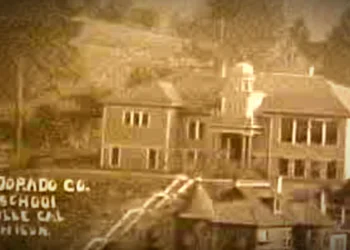By Cris Alarcon, InEDC Writer. (Nov 1, 2025)
Pollock Pines — The El Dorado Irrigation District has declared an emergency and moved to replace the aging liner and floating cover on Reservoir 1 — a 2.8-million-gallon, lined and covered storage tank that serves Pollock Pines and Camino — after routine inspection revealed holes, ripped seams and other signs of failure that exceed the system’s design life.
District documents show the liner and Hypalon floating cover were installed in 1989 and have surpassed their 20–30-year design life; staff determined the damage was too extensive for patch repairs, and on Oct. 14 the Board adopted a resolution declaring an emergency and authorizing immediate action. Construction is scheduled to occur during a period of lower water demand with work expected to be complete in March 2026.
“The Project consists of two primary components: construction of a bypass system and replacement of the floating cover and liner,”
the District’s Notice of Exemption states — language that sums up the work required to keep treated water isolated and free from environmental contamination during repairs.
To keep service steady while the reservoir is taken offline, the project will build a temporary bypass system that includes about 120,000 gallons of temporary storage, modifications to yard piping and upgrades to pumping equipment (variable frequency drives) at the Moose Hall and Sportsman’s pump stations. Once the bypass is operating, crews will remove the old liner and cover and install new, longer-life materials.
Reservoir 1 is integral to local water operations: it provides additional contact time for chlorine disinfection during the summer and acts as winter storage to balance supply and pressure for customers in Pollock Pines and Camino. Because of how the distribution system is configured, the reservoir cannot be taken out of service without the bypass — a key reason why the emergency replacement was judged necessary.
The District originally planned a longer-term project — replacing Reservoir 1 with two new concrete tanks — but officials say the emergency liner and cover replacement is the only viable interim fix to protect water quality and regulatory compliance while the Capital Improvement Plan evaluates long-term options. Work on the short-term fix preserves system reliability while the District considers permanent alternatives.
Local customers should not expect interruptions beyond routine operational impacts. The District is handling procurement and bid postings for related components and environmental filings are listed on the District web site and CEQA filing records. Customers with questions may contact EID’s environmental staff as listed in public filings.
A failing liner or cover can expose stored treated water to sunlight, debris or soil contact — risks that could affect water quality, pressure and regulatory compliance. The emergency project is designed to maintain uninterrupted service and protect public health while the District plans a longer-term replacement solution.










